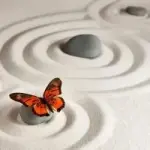 Not long ago, every living species of amoebas, humans, roses, zebras and all the species in between traveled on a pilgrimage back in time to meet their original ancestor, the founding living thing. Along the way each species greeted its ‘concestors’ – the common ancestors that they share with other living species.
Not long ago, every living species of amoebas, humans, roses, zebras and all the species in between traveled on a pilgrimage back in time to meet their original ancestor, the founding living thing. Along the way each species greeted its ‘concestors’ – the common ancestors that they share with other living species.
Our species, the humans, had an amazing journey. At each rendezvous with a concestor we joined living cousins – sometimes a few, sometimes thousands. What was old became new: We gained a tail, could see in the dark, were hatched instead of born, breathed under water. We lost our bones, then our bodies. Then at our fortieth rendezvous, 3.8 billion years ago, all of today’s 8 million species found ourselves in the presence of the concestor of us all.
The grand study of evolution-in-reverse is Richard Dawkins’ The Ancestor’s Tale: The Dawn of Evolution (2004; revised with Yan Wong, 2016). Dawkins adopted the device of stories-and-pilgrimage from Geoffrey Chaucer’s Canterbury Tales, written in the 1300s. In “The Gorilla’s Tale,” “The Peacock’s Tale,” and many others, Dawkins, eminent scientist and prominent atheist, offers expert lessons in biological change while acknowledging at the end that this tracing of species has been his own “true pilgrimage” (700).
As humans, Dawkins and the readers travel only the human itinerary of the pilgrimage. We learn little about the ancestral meetings of countless animals and plants until they rendezvous with us, at which point the growing crowd of cousins continues together. For this is a book of coming together – not of separating down diverging roads but of merging, and merging again. Evolution in reverse. It is an awkward perspective at first. What is Dawkins getting at?
He explains his frustration with misperceptions of evolution as a march of “progress” that has produced humans as its “most evolved” result. We are prone to viewing other species around us, fine as they are, as less evolved than us, as if today’s mice and dandelions reached an evolutionary dead-end and then managed to hang on. But such a view is distorted. Over time, all species change. Everything alive today has the fullness of evolution behind it. The view backwards reminds us of that. “Go backwards and, no matter where you start, you end up celebrating the unity of life. Go forwards and you extol diversity” (6).
The milestones are the concestors.
What is a concestor? A moment in history when there were two animals in the same species, one of whom became the ancestor of [for example] all humans and no wombats, while the other became the ancestor of all wombats and no humans. They may well have met, and may even have been brothers. (27)
For a guide through Dawkins’ 700 imposing pages, we are fortunate to have the work of Connie Barlow, teacher and science writer. Her 34-page text Greet the Concestors is available for free on the Internet. Here is her description of the first Rendezvous for humans, followed by highlights of four later (earlier?) ones. Keep in mind that the concestors, though some have familiar names, did not look the same back then as they do today.
#1 Rendezvous: Greet your CHIMPANZEE cousins!
TIME: 6 million years ago, during the late part of the Miocene epoch of our Cenozoic Era.
WHERE: a forest clearing in Africa
WHO JOINS? Chimpanzees and Bonobos (pygmy chimps), which are the 2 living species of genus Pan.
CONCESTOR 1 is your 250 thousandths great-grandparent.
FORM: This concestor looks more like a chimp than a human; it probably makes and uses tools. Although we spend a lot of time on the ground, we feel safest in trees and certainly sleep there.
TOTAL # LIVING SPECIES ON THE PILGRIMAGE NOW: 3 [humans, Chimps, and Bonobos]
Rendezvous #5, 25 million years ago. “Nearly 100 species of colobus and langur monkeys and baboons” join the pilgrims, who now number 118 living species. With Concestor #5, we now “have a tail for the first time!”
Rendezvous #17, 340 million years ago. Greet your Amphibian cousins. “5,000 species of living frogs, toads, and salamanders” join the pilgrimage, for a total of 27,000 species. “We spend our early youth as a fishlike tadpole! This is the first time we can breathe underwater…and we still have lungs to breathe on land.”
Rendezvous #36, time unknown. Our plant cousins. This concestor, the shared ancestor of plants and animals, is a primitive single cell some of whose descendants will absorb photosynthetic bacteria to become the 30,000 species of all living land plants, even the giant redwoods. The pilgrims now number 2.7 million species.
Finally, #40, 3.8 billion years ago, is not actually a Rendezvous, for every species living today is already present. Barlow writes that we witness the “first semblance of life – whatever that might have been. …Praise LIFE! And praise our Planet Earth and the vast and creative Cosmos which, together, are capable of manifesting Life!”
As for the closing of Ancestor’s Tale, Dawkins explains why he scorns reverence for beliefs in the supernatural while sharing with others reverence for the natural world as appreciatively understood:
‘Pilgrimage’ implies piety and reverence. I have not had occasion here to mention my impatience with traditional piety, and my disdain for reverence where the object is anything supernatural. But I make no secret of them.… My objection to supernatural beliefs is precisely that they miserably fail to do justice to the sublime grandeur of the real world. They represent a narrowing down from reality, an impoverishment of what the real world has to offer. (700)
As for me, I like imagining that the shrubs and birds and dogs and squirrels I see every day have all returned from their pilgrimage to the past, as I have. We look at each other knowing what a long way we have all come.
Learn about Membership in the Spiritual Naturalist Society
__________
The Spiritual Naturalist Society works to spread awareness of spiritual naturalism as a way of life, develop its thought and practice, and help bring together like-minded practitioners in fellowship.












